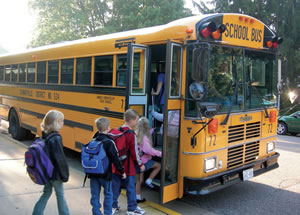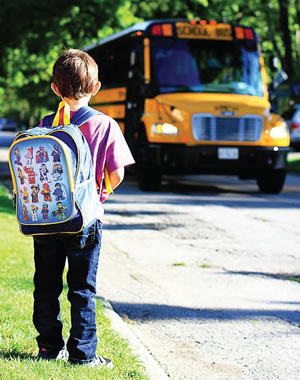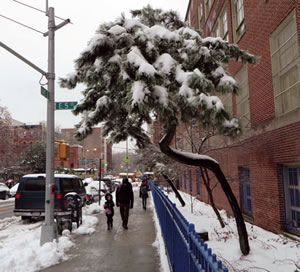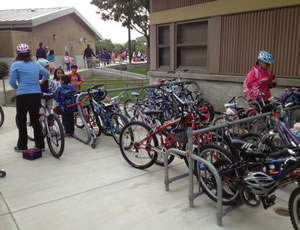School Transportation
EDITOR’S NOTE: The issues pertaining to getting students to and from school are varied and can be complicated. Due to that fact, we have broken this article into several sections – one on safety, another on designing drop-off areas, Bike to School Day and an interesting recounting of how the “polar vortex” affected a Georgia school district.

PHOTO © TYHATCH/FLICKR
Tips for Achieving Transportation Safety
“When I think of transportation safety, I think of an orderly school bus, with students sitting in their seats and not displaying behavior that distracts the driver,” says Ron Farrand, director of Facilities and Transportation for Carmel Clay School District in Carmel, Ind.
“We let everyone — administrators, parents and students — know that a school bus full of children is equal to two classrooms of students sitting behind the teacher and the teacher is trying to drive a bus,” Farrand says.
An orderly bus is a strong element of transportation safety, as are drivers who are well trained and drive safely. Here are some ways Farrand and David Guillory, M.Ed., transportation director at DeKalb County School District in Stone Mountain, Georgia, achieve transportation safety.
1. Training: “We have a strong driver training program,” says Guillory. “We go above the 12/6/6 (12 hours in the classroom/ 6 hours on a school bus without students/6 hours on a school bus with students) required by the state.” Additionally, Guillory has a staff development program, the bulk of it employed at the beginning of the school year.
2. Meetings: “We have a safety meeting with the Georgia Department of Education Transportation Division every year,” says Guillory. Also, he has regular meetings with supervisors and managers and with drivers to give them the latest information from the state and district and to reviewareas of weakness.
3. Ongoing Communication: “We want everybody to know what they can do to keep order on the bus,” Farrand says, “and what we need to accomplish to get students home safely.” Therefore, communication is for every stakeholder: drivers, parents and students.
For drivers, Guillory regularly sends them reminders. For parents, Farrand goes to great lengths to let them know what’s expected. “Everything is posted on our website,” he says. “Behavior policies, written guidelines of how we develop routes, what the routes are — all the information is available.”
And students are taught safety procedures, such as standing outside the bus’s safety zone as it pulls up. It’s especially important to communicate and educate students, because they’re the ones on the bus, not their parents.
4. Procedures: “We stress following procedures,” says Guillory, “such as drivers checking their buses at the end of every route to make sure no students or items belonging to students are left on the buses.” Farrand agrees, noting consistency in following procedures is important. If one bus is known as the party bus, it will become known, and that can have a negative effect on the other buses.

PHOTO © STATE FARM/FLICKR
Designing Student Drop-Off Areas for Safety
“The most important issue when designing student drop-off areas is safety,” says Jeff Bolinger, RLA, a senior associate with Fanning Howey, which has offices across the country. Here, he indicates the features of a well-designed student drop-off area that promotes safety first.
1. Keep the bus and parent drop-off areas separate. In doing so, Bolinger recommends considering the following three thoughts. First, know your customer: What is the ratio of students arriving on buses to students being dropped off? Factors affecting this ratio are urban (more parent drop offs) vs. rural (more bus drop offs) and school level (more drop offs at middle schools for pre- or post-school activities).
Second, are there certain direct locations on the building for students to enter? Knowing this makes a difference in how the parking and circulation areas are designed around the building.
Finally, is it possible to have multiple exits/entries, one for students riding buses and one for students being dropped off? If economics don’t allow for that, then design an exit where all the buses are released first, followed by parent pick up.
2. Provide adequate queue-up space for buses and parents. Ideally, this is one lane each for safety. Bolinger notes that sometimes the space simply isn’t available and sometimes situations change through time. At one school, drop off changed through the years from primarily bus to primarily parent, and administrators had more than 700 cars coming onto the site for drop off. The remedy was to create, for student drop off, double lanes. It isn’t an ideal situation in terms of safety but, with assistance from staff, it ensures greater efficiency.
3. Provide adequate walk space. A six-foot-wide walkway seems as though it’s enough but, in reality, it isn’t when students are streaming out of a school at the end of the day. Similarly, says Bolinger, “A 10-foot-wide walkway may seem too wide, but it serves a function during release.” Additionally, he advocates ensuring walkways are accessible with ramps or at-grade surfaces all the way into the school.
4. Provide adequate turning space for buses. Buses require a large turning radius to get into and out of parking lots. Without that space, drivers run over curbs. Bolinger indicates that a 12-foot-wide space is normal but 15 works better, and a 50-foot radius is required for turning.
With proper planning, safe and secure student drop-off areas are easily achievable. “However” Bolinger notes, “even if we have the best design plan in the world, it’s meaningless if administrators have a chaotic release of students. So safety is best achieved with combined physical plans and administrative plans.”

PHOTO © EDENPICTURES/FLICKR
Atlanta-Based School District Tackles Winter 2014 Transportation Challenges Head On
The winter of 2014 was a doozey, as people in the Atlanta area well know. “We had some pretty cold temperatures this winter,” vouches David Guillory, M.Ed., Transportation director at DeKalb County School District in Stone Mountain, Ga. “In fact, it has been a couple of decades since we had such low temperatures.”
Fortunately, Guillory’s district-operated department of 1,027 transportation operations staff rallied, rallied again and rallied once more, using the tenets of safety and communication to achieve transportation success.
Tuesday, Jan. 7. The first day back to school after winter holidays for students, teachers and administrators. However, because of high winds and extremely cold temperatures, the district opts to cancel school in favor of keeping students and staff safe, knowing that not everyone in that mild climate is adequately protected with the necessary outerwear for the route to and from school.
Still, anticipating school to be in session the next day, a team of supervisors and mechanics braves the cold and reports to work to ensure all 964 buses are in working order.
Wednesday, January 8. The weather is still cold — Guillory recalls it being 6°F with a wind chill of -10°F — but school is on. “The mechanics arrived at 4 a.m. to make sure the buses started,” he says, “and that was huge because the temperature was so low.” Drivers come in early as well for pre-trip preparations. With 856 buses, they don’t want to wait until it’s time to roll to be ready.
What makes the morning interesting is a broken water main at a busy intersection. “It was shooting water 80 feet in the air,” Guillory says, “and, as it was coming back down, it was freezing on power lines, trees and roads. It looked like a winter wonderland.”
As a result of the broken water main, an elementary school full of 900 students is without water, requiring evacuation. “We implemented our evacuation plan,” says Guillory, “which began with alerting the transportation supervisor and managers that evacuation was needed. They, in turn, alerted the necessary drivers to return to the school shortly after the students had arrived. The students were safely moved to predetermined sites.”
Guillory notes that the evacuation was handled well: “Communication is key. We communicated all morning on this situation.” Additionally, the post-evacuation reports are positive. “Parents talked about how well organized it was,” he says, “and we ourselves were quite happy with how well the process went and ensuring all the students were safe.”
Tuesday, Jan. 28. Snow. The mechanics arrive early that morning to start the buses. “At a 4 a.m. meeting,” says Guillory, “we determined that we might have to dismiss early. As drivers came in at 5:30 a.m., we alerted them to be on standby for a phone call and/or radio communication to pick up students early. That’s what we did, and that’s how we got our students home safely.” Because of this planning, only one bus becomes stuck in the afternoon snow. Other districts weren’t as fortunate in the treacherous storm where streets became gridlocked with everyone trying to go home at the same time, resulting in multiple buses stuck for hours — even overnight — and students marooned at schools overnight.
“I can’t say I’m going to miss winter once it’s gone,” Guillory sums, “but I can say that it has affirmed that my department’s safety and communication levels are where they need to be.”

PHOTO © BIKE EAST BAY/FLICKR
Celebrate Bike to School Day on May 7
National Bike to School Day, a day designed to promote active transportation to school and celebrate safer streets, healthier habits and cleaner air, is scheduled for May 7.
The first National Bike to School Day took place in 2012, in coordination with the League of American Bicyclists’ National Bike Month and building on the success of International Walk to School Day, which began in 1997. In 2012, 950 local events in 49 states encouraged students to safely bicycle or walk to school. In 2013, more than 1,700 schools participated.
There are many ways to show students that bicycling to school is fun and feasible, and the organization’s website (www.walkbiketoschool.org) notes that, “in general, events are structured three ways, with many variations to each.” They are:
- walk or bicycle from home, which encourages students to walk or bicycle to school;
- designated starting points, which identifies one or more locations where students gather to walk or bike to school together; and
- walk or bicycle at school, which promotes bicycling at a school assembly, recess or as part of a class activity.
Even if you don’t have time to organize an event for 2014, it’s not too early to begin planning for 2015. To get started, or for more information, visit the above-mentioned website.
This article originally appeared in the issue of .